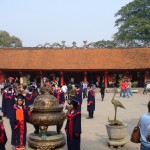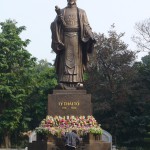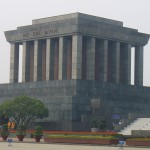In Ho Chi Minh City (or Saigon), you see and hear a lot about the new capitalism and the future. In Hanoi, the seat of the communist government, you see and hear a lot about Ho Chi Minh, kingdoms and the past.

In 1802, Hanoi lost the center of royal power to Hue, as well as the Confucian university which had educated men for over 700 years. More recently, through war, reconstruction and natural decay, Hanoi lost most of the ancient structures from its past, though the repurposing of the university as a temple kept that rebuilt over the years.
But Hanoi still honors the ghosts of its past. All around the city, it memorializes its founding a thousand years ago, its unifying king Le Loi from 500 years ago, its French heritage from 150 years ago, and the long battle for independence and reunification in the 20th century.
Moreover, unlike many fast growing cities with a bursting population and economic success, it tries to honor all these pasts while accommodating the present.
Two of the most visited areas recall the French and a more medieval past. The French quarter was where the colonialist French lived. It does not, however, feature the most French looking buildings. Nonetheless, even though newer buildings have pushed out many of the older ones, the quarter still shows the French influence in its broad, tree-lined boulevards The most European buildings used to be their administrative centers. The Vietnamese did not destroy these when the French were overthrown, but instead repurposed them for their ministries or foreign embassies.

The streets of the old quarter, however, are narrow, oddly-angled and wayward, crammed tightly with market stalls and food shops. Here the original buildings may be gone, but the pastiche of styles that include French influences, communist era concrete and Asian touches, is constantly engaging. To preserve this character, the plan here is to reduce traffic and congestion by creating pedestrian zones.
And there is a lot more charm in the central city. Sometimes called the “city of lakes” because it has dozens of them, residents enjoy gracious parkland around which they can take their exercise or loll on benches in ardent conversation. Out there on the periphery of the city, tall buildings and shopping centers march in and the first part of a subway is under construction. In the heart of the city, it’s all about keeping faith with the past.

Meanwhile, flanking the central lake that separates the historic sections – and out of which John McCain was rescued when his plane was shot down – two memorials honor those most notable kings. One was Ly Hai Tho the founder of the city in 1010. Legend has it that he picked this spot for his kingdom because a lucky golden dragon rose up from here into the sky while the king was scouting sites along the Red River.
Across the lake, a garden-like memorial honors the 15th century king Le Loi, who unified the country by defeating the Chinese. Legend has it that as peace settled on the land, a giant tortoise greeted him while he was boating on this lake. The tortoise miraculously asked for the sword now that war was over. Le Loi wisely complied by tossing it the sword, then renamed the lake in the tortoise’s honor. That animal is itself memorialized by the much rebuilt pagoda in the center of the lake.

Not surprisingly, these two kings also define the dual national narrative of Vietnam, a story of embattled independence constantly threatened by foreigners and also the parallel story of unifying a divided country. Throughout the north of the country and frequently around Hanoi, you see gravesites and memorials to the millions of Vietnamese who died in the 20th century accomplishing both goals against the French and the United States.
So it’s not surprising that Ho Chi Minh has the grandest memorial here, for he is honored as the leader who accomplished this.

His mausoleum complex actually rivals in scale the royal ones in Hue, while the tomb itself emulates Lenin’s in the Kremlin. Every morning hundreds of tourists queue up in a line to the side and then, under the watchful eyes of white-uniformed soldiers, file along the length of the massive granite tomb to the red carpeted entrance (hats off, please). Then it’s up a few steps to file in silence past Ho Chi Minh’s body, asleep to all appearances in a golden glow.
This is not the veneration he wanted, we’re told, and we can believe it. He asked to be cremated, but his successors atop the Vietnamese government preferred to keep a cult-like glorification rather than what Ho wanted, for their own reasons. And we can believe this story because you can see, in the same complex, evidence of a much more modest man. His home and work space is a tiny, unadorned, almost prairie-style building: the rooms look more monastic than dictatorial. Nearby is the palatial governor’s house that he rejected for the purpose, though that French building was kept intact and restored.

Not that Ho was a saint either for, like the communist leaders of other countries, he instituted various forms of repression against suspected opponents, intellectuals and even the Buddhist monks that had supported him against the south Vietnam government. He understood the levers of power, and could be a ruthlessly effective commander or leader. He made some of Mao’s mistakes, but never turned on his people like Pol Pot in Cambodia. Still, only after his death, did the Vietnamese embrace trade, capitalist-style ownership and material progress, as the Chinese had already done.
And perhaps it is more appropriate to memorialize Ho in this way. For, as we’ve noted before, the Vietnamese traditionally bury their dead, not cremate them. Here, individuals are often venerated. Pagodas may honor Buddha, but temples honor respected predecessors and teachers. So one must honor the dead, particularly your ancestors, to help them move on to heaven for their good qualities and to ensure that their spirits don’t come back to trouble you. The Vietnamese are a superstitious lot, our guide keeps telling us. So, rest in peace, Ho Chi Minh.
And that’s Hanoi. Despite losing its ancient university, it’s the home of 56 now. Despite fighting the French for a half-century, they have kept their buildings and some of their style. Despite fighting the U.S. for over a decade, they forgive and forget, melding western capitalism into their socialism.
In Hanoi, it’s never just about the future; it’s also about honoring the ghosts, the past.
(For more pictures from Vietnam, CLICK HERE to see the slideshow at the end of the Vietnam itinerary page.)

